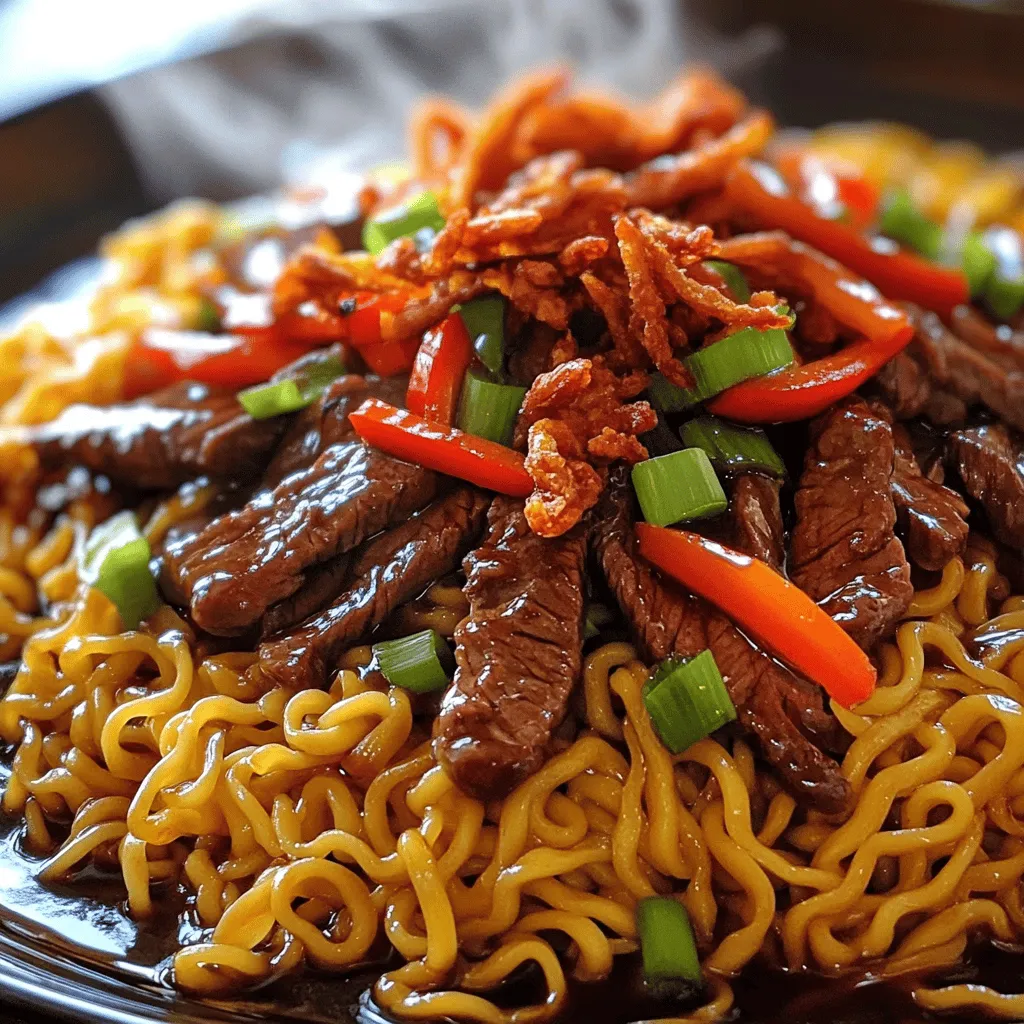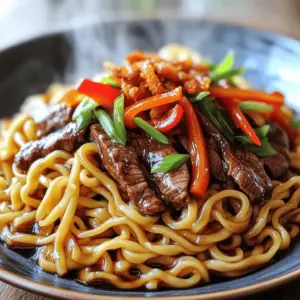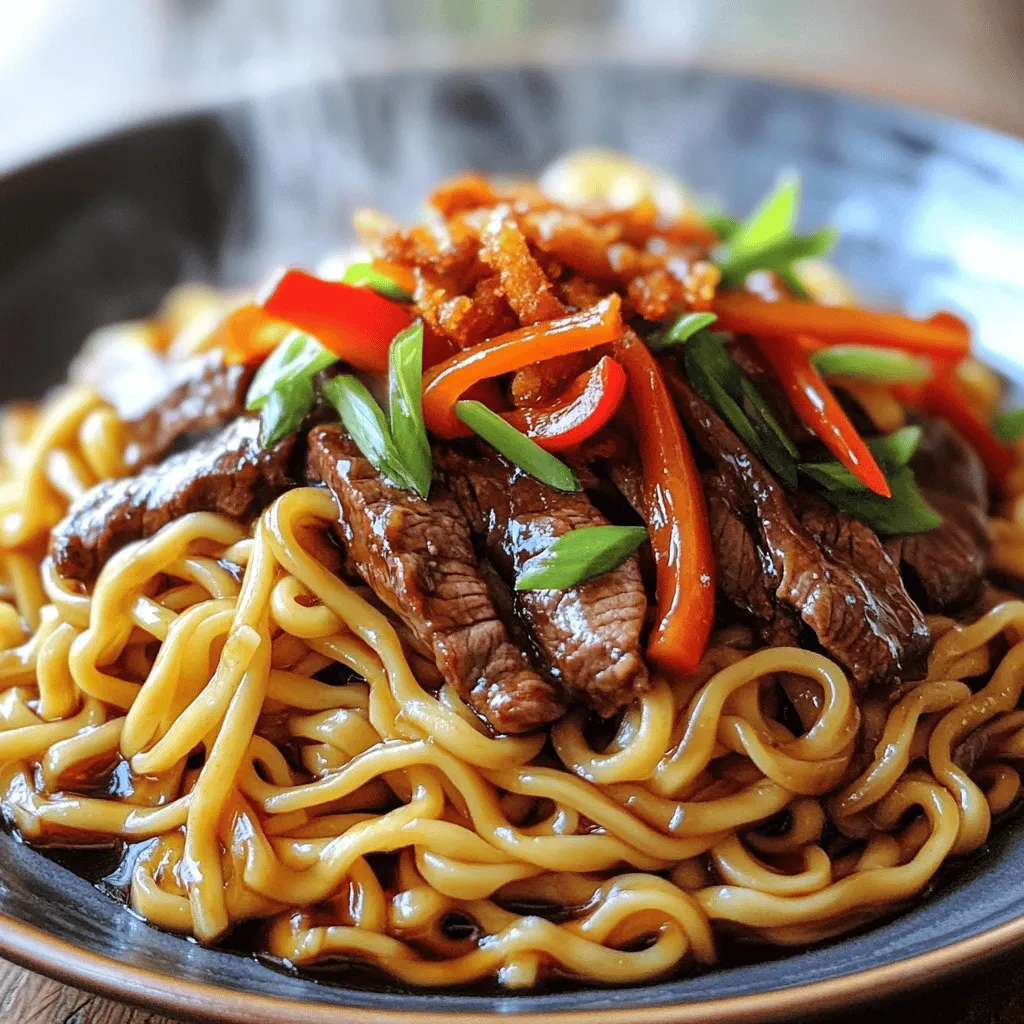Are you tired of ordering the same takeout every week? Let’s change that! My Better-Than-Takeout Mongolian Beef Noodles are not just quick to make; they pack a flavorful punch that rivals your favorite restaurant. With simple ingredients and easy steps, I’ll guide you to create a dish that wows your taste buds and impresses your family. Ready to boost your dinner game? Let’s dive into the recipe!
Ingredients
To make Better-Than-Takeout Mongolian Beef Noodles, gather the following ingredients:
– 8 oz. egg noodles
– 1 lb. flank steak, thinly sliced against the grain
– 3 tablespoons soy sauce, divided
– 1 tablespoon hoisin sauce
– 1 tablespoon packed brown sugar
– 2 teaspoons sesame oil
– 1 tablespoon vegetable oil
– 4 cloves garlic, minced
– 1 inch fresh ginger, grated
– 1 red bell pepper, thinly sliced
– 1 cup green onions, chopped (divide white and green parts)
– 1 tablespoon cornstarch
– 1 tablespoon water
– Salt and black pepper to taste
These ingredients create a mix of flavors and textures. The egg noodles give a soft base. Flank steak adds heartiness. Soy sauce and hoisin sauce bring rich umami. Brown sugar balances the saltiness. Sesame oil adds warmth, while garlic and ginger provide a fragrant kick. Red bell pepper and green onions add color and crunch. Cornstarch helps the beef stay tender. Using fresh ingredients makes all the difference. You’ll taste the care in each bite!
Step-by-Step Instructions
Cooking the Noodles
– Preparing and Draining Noodles: Cook 8 oz. of egg noodles as per the package. Drain them well and set aside. This step is key to prevent sogginess.
– Ensuring Noodles Don’t Stick: To keep the noodles from sticking, toss them with a teaspoon of oil after draining. This will help them stay separate.
Marinating the Beef
– Time and Method for Marinating: For the best flavor, marinate 1 lb. of flank steak for 15 minutes. Mix it with 1 tablespoon of soy sauce, 1 tablespoon of cornstarch, and salt and pepper.
– Importance of Even Coating: Ensure each piece of beef is coated well. This helps the beef absorb the flavors during cooking.
Cooking the Beef
– Heat Levels and Cooking Time: Heat 1 tablespoon of vegetable oil in a skillet over medium-high heat. Cook the beef in one layer for about 3-4 minutes.
– Tips for Achieving the Perfect Browning: Avoid stirring too much. Let the beef sit to get that nice brown crust. This adds flavor.
Sautéing Aromatics
– Garlic, Ginger, and Green Onions: After removing the beef, add 1 tablespoon sesame oil. Then add 4 cloves of minced garlic, 1 inch of grated ginger, and the white parts of 1 cup of chopped green onions. Stir for about 30 seconds.
– Avoiding Overcooking: Watch carefully! You want the garlic golden, not burnt. This adds a lovely aroma.
Adding Vegetables
– Cooking Red Bell Pepper: Toss in 1 thinly sliced red bell pepper. Stir-fry for 2-3 minutes until it softens but stays bright.
– Maintaining Color and Crispness: You want the pepper to be tender yet still vibrant. This keeps the dish appealing.
Preparing the Sauce
– Mixing Ingredients for Sauce: In a bowl, whisk 2 tablespoons of soy sauce, 1 tablespoon of hoisin sauce, 1 tablespoon of brown sugar, and 1 tablespoon of water.
– Simmering for Flavor: Pour this sauce over the vegetable mix in the pan. Let it simmer gently for a few minutes to meld the flavors.
Combining Ingredients
– Mixing Beef, Noodles, and Vegetables: Return the beef to the pan and add the drained noodles. Toss everything gently to coat well.
– Final Cooking Tips: Heat all ingredients together for 2-3 minutes. This ensures everything is warm and flavors blend.
Presentation Tips
– Serving Techniques: Serve in deep bowls for a relaxed vibe. This makes the dish inviting.
– Garnishing for Appeal: Top with extra green onions and sesame seeds. This adds a nice touch and makes it look gourmet!
Tips & Tricks
Enhancing Flavor
– Recommended Seasonings: Use fresh garlic and ginger. They add depth to the dish. You can also sprinkle a little red pepper flakes for extra heat.
– Tips for a Richer Sauce: Mix soy sauce, hoisin sauce, and brown sugar. This combo gives a sweet and savory taste. Adding a splash of water helps combine the flavors well.
Cooking Techniques
– Best Practices for Stir-Frying: Heat your pan before adding oil. This helps cook the beef quickly. Always keep the beef in a single layer for even cooking.
– Achieving Tender Beef: Slice flank steak against the grain. This makes each bite tender. Marinate it with cornstarch and soy sauce for extra flavor and tenderness.
Common Mistakes
– Common Errors to Avoid: Don’t overcrowd the pan. This can steam the beef instead of browning it. Also, be careful not to burn the garlic when sautéing.
– Troubleshooting Overcooked Ingredients: If your beef is tough, try slicing it thinner next time. For overcooked veggies, cook them just until soft but still bright in color.

Variations
Alternative Proteins
You can easily switch out the flank steak for chicken or tofu. Both options work well. For chicken, use boneless thighs or breasts. Cut them into bite-sized pieces. For tofu, use firm or extra-firm tofu for the best texture.
When cooking chicken, use the same method. Just adjust the cooking time. Cook until the chicken is no longer pink. For tofu, press it first to remove excess water. Then, cube and sauté it until golden.
Vegetable Additions
Fresh veggies can enhance this dish’s flavor. Try adding seasonal vegetables like snap peas or bok choy. They add color and crunch.
A good mix includes:
– Snap peas
– Carrots, julienned
– Broccoli florets
Add them after cooking the beef. Stir-fry for a few minutes until tender but crisp.
Gluten-Free Options
If you want a gluten-free version, swap the egg noodles for rice noodles. They cook quickly and absorb flavors well.
For the sauce, use tamari instead of soy sauce. It has a similar taste without gluten. Check the hoisin sauce too; many brands offer gluten-free versions. Adjust the sugar and vinegar in the sauce if needed to keep it balanced.
Storage Info
Refrigerating Leftovers
– Store your leftovers in airtight containers.
– Keep them in the fridge for up to 3 days.
Storing your Mongolian beef noodles properly helps keep them fresh. Make sure to let the dish cool down before you put it in the fridge. This helps prevent extra moisture, which can make the noodles soggy.
Reheating Instructions
– Use the microwave for quick heating.
– Heat on medium power to avoid overcooking.
To keep the texture nice, add a splash of water or soy sauce when reheating. This adds moisture back into the dish. Stir every minute to ensure even heating.
Freezing Tips
– Freeze leftovers in freezer bags or containers.
– Use within 2 months for best taste.
If you freeze your noodles, it’s best to separate the beef and noodles. This helps them stay fresh. When you want to eat them again, thaw in the fridge overnight. Then, reheat on the stove for the best results.
FAQs
How long does the marination process take?
The ideal marination time for the beef is 15 minutes. This short time allows the meat to soak up some flavor from the soy sauce and cornstarch. It helps make the beef tender and delicious.
Can I use a different type of noodle?
Yes, you can use other noodles. Some great alternatives are rice noodles or udon noodles. Just adjust the cooking time based on the type you choose. Always follow the package instructions to ensure they cook well.
What can I substitute for hoisin sauce?
If you don’t have hoisin sauce, try using a mix of soy sauce and peanut butter. You can also use teriyaki sauce or a blend of soy sauce and brown sugar. These options will keep the flavor close to the original dish.
How can I make this dish spicier?
To add heat, include red pepper flakes or sliced fresh chili peppers. You can also add a dash of sriracha or chili oil to the sauce. Adjust the amount based on your spice preference.
Can I make Mongolian Beef Noodles in advance?
You can prepare this dish ahead of time. Store the cooked noodles and beef separately to keep them fresh. When ready to eat, simply reheat them in a pan. They taste great even after a day in the fridge!
You now have the tools to create delicious Mongolian Beef Noodles. We covered key ingredients, cooking steps, and helpful tips throughout the process. Remember to marinate the beef well and avoid overcooking the veggies for the best taste. Feel free to experiment with proteins and veggies to suit your preferences. By storing and reheating properly, you can enjoy great flavors later. With practice, you’ll impress everyone with your skills. Enjoy making this dish and sharing it with friends and family!

